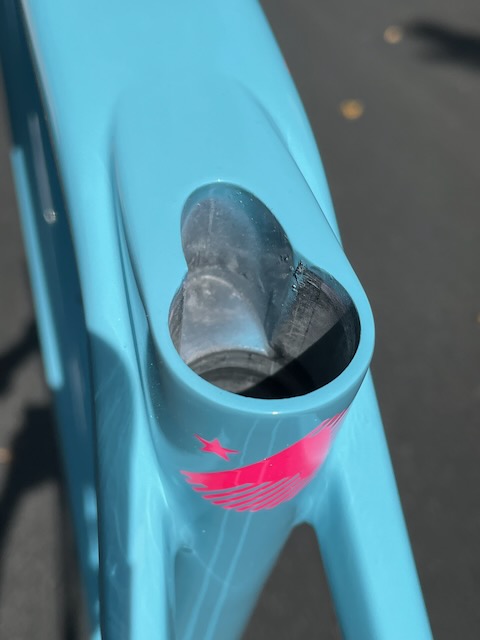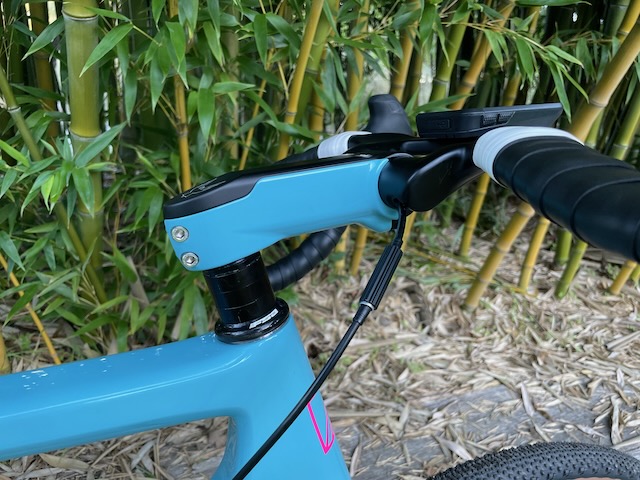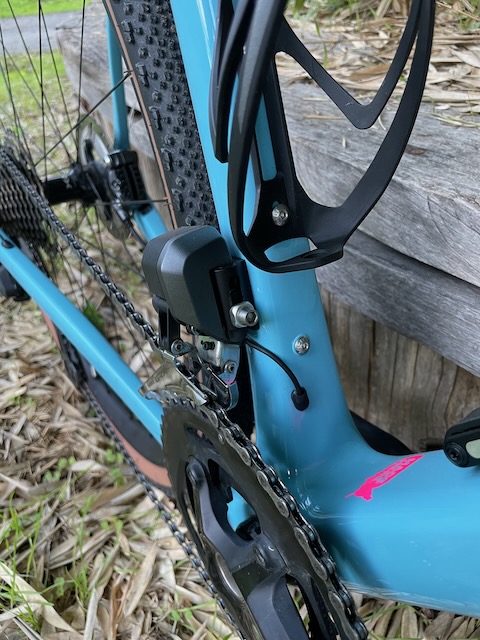A gravel bike is not a road bike with wider tires. At first, that’s how many were conceived, but the gravel bikes that caught on and began influencing other designs came with design features that would be frowned on in road bikes.
Those hallmarks include heavier, more durable frames; more bottom bracket drop; yes, greater tire clearance and some include other features such as routing for a dropper post or bag mounts for light touring. Many are also starting to route more and more of the cables and hoses internally.
It’s into this setting that Allied Cycle Works introduced their follow-up to the Alpha Allroad, the Echo. Among the changes the Echo saw from the Alpha Allroad were more bottom bracket drop, increased tire clearance and full internal routing of the Di2 wires and hydraulic brake hoses, all the way from the bar to the component.
I’d previously reviewed the Alpha Allroad and it was the bike that demonstrated so clearly how important a stiff top tube is to good handling on rough roads.

Quiver killer
The Allied Echo is pitched as an all-road bike, and that’s truer than can be guessed by looking at photos. In designing the Echo, Allied Cycle Works’s head of engineering, Sam Pickman, took an idea that’s been popular in suspension design—the flip chip—and adapted it to drop bar bikes. The idea goes like this: With some suspension designs, there are a pair of aluminum inserts that, depending on their orientation will change the bike’s geometry slightly, changing the bottom bracket drop and head tube angle.
With the Echo, Pickman used aluminum inserts in the dropouts to change the Echo’s geometry so that it could be ridden as a gravel bike, or as a road bike. In one orientation, the chips move the thru-axle away from the fork crown, increasing tire clearance. In the rear, with the chips positioning the thru-axle as far from the bottom bracket as possible, giving maximum tire clearance.
However, flip the two chips in the fork and the two chips in the dropouts and the Echo’s geometry changes: The wheelbase shrinks and the bottom bracket drop decreases and the head tube and seat tube angles both increase. Fork rake and front-center decreases. In the gravel configuration, the trail is a quick 5.68cm—that’s quick for a gravel bike; those classic Italian steel road bikes that descended with all the style and chill of Grace Kelly typically had 5.9cm of trail—while in the road position it drops to an even quicker 5.48cm. It’s a remarkable transformation.
What this adds up to is that someone could purchase one bike and add a second set of wheels and have two bikes—with an identical fit. One set of wheels could run 40mm-wide tires while the others could roll on 25mm tires.
So much stuff, so little room
Because gravel riding has grown out of road riding, some values came set in stone: Dropout spacing and bottom bracket width are notable examples. The combination of bottom bracket width and the typical Q-factor of road and gravel groups means there isn’t much room for wide tires, at least one chainring and two chainstays.
To make the Echo both strong enough and stiff enough, the drive-side chainstay exits the bottom bracket at roughly 7:00 before twisting up to make its run to the dropout. The unusual chainstay shape makes room for the chainstay to be thicker without sacrificing tire width.
As I mentioned earlier in the review, the Echo is one of the new generation of bikes that features completely internal routing of hoses, cables or wires. I built the Echo up with Shimano’s GRX Di2 group and the hydraulic hoses and shifter wires exited the levers, entered the bar, then passed inside the stem and down into the fork steerer. From the steerer, the hose for the fork’s brake simply continues down into the blade. The Di2 wires run out of a port at the back for the fork and down the down tube to a junction box. The battery is hidden in the down tube. The rear brake hose passes out of that same fork steerer port, into the down tube and beneath the bottom bracket as it continues its run up the left chainstay and out to the brake.
Building a bike of this sort isn’t the sort of thing a shadetree mechanic should take on. It’s been a few presidents since I was a professional mechanic and even with all the right tools, getting all the hoses and wires through the bar and stem and then routed through the fork was the most difficult assembly I’ve ever undertaken. God forbid you should ever have to replace a hose or wire. Given how many shops charge labor by the hour now, maintenance on a bike like this won’t be quick or cheap. Also, considering the sharp bends necessary to negotiate the run from the bar through the stem and on to a derailleur, cable-actuated shifting is not an option with this bike.
My build has an extra complication in that I am running a dropper post. There is a badge affixed to the down tube, not the head tube, and that badge hides an opening in the down tube that helps the mechanic with routing hoses and wires. I drilled a hole in my badge and the housing runs to the bar, sharing space with the front brake hose before exiting the bar to the dropper release lever. There simply wasn’t room enough in the fork, stem and bar to run the dropper cable and housing. Theoretically, it looks like there’s enough room to run everything, but I realized I wanted to see my kids again.

Bouncing along
The litmus test of any drop bar bike is how it descends. A bike that doesn’t descend well will have other weaknesses, but a bike that descends well won’t suck at anything. That’s because what makes for a good descending bike—stiff front triangle, good weight distribution and a low center of gravity—will help a rider whether they are sprinting, riding no-hands or enjoying a lazy spin after work.
Once I got the Echo built, the first thing I did was take it on a gravel ride in Annadel State Park. There’s an out-and-back that I like to do on gravel bikes; I begin by climbing the wide fire road, Canyon. It leads to Lake and Lake leads to Warren Richardson, and the entire route is at least 8 ft. wide, and at times nearly 20 ft. across. Canyon is super rocky, at times just a field of baby head rocks. This fire road is why I never run a tire narrower than 38mm. Anything narrower and I’ll have to run it at such a high pressure that I’ll bounce around like I’m on a trampoline. I’m happiest (and most comfortable) on 40mm-wide tires.
The first thing I noticed was how stiff the frame was anytime I stood on the pedals. It was stiff, yes, but it wasn’t crazy stiff. Later, when I set it up with a set of road wheels, I was able to confirm that the frame is stiff without being overly so by running a set of road wheels with narrower tires. Having ridden some of the stiffest frames ever made, I can verify that there can be too much of a good thing. What’s important for a gravel bike is less stiffness in power transfer than stiffness when turning.
What I notice with frames that aren’t stiff enough to keep both wheels in the same plane when leaned over is that the front wheel tends to “seek,” that is, wander slightly, as if it is trying to find the right line to carve. This does not inspire confidence. This is one of the regards in which the Allied Echo really performed well.
As I noted earlier, the frameset has 5.68cm of trail, which gives it very quick steering. That pays off on fast fire-road descents and smoother singletrack that winds; unfortunately, there isn’t much of the latter around here. Such quick handling did cause me to feel a bit nervous in especially rocky sections. When the surface is relatively smooth, the Echo carves like fatties in fresh pow-pow.
Idea vs. execution
I’m crazy about this frame set for several reasons. First, I love just how inventive it is; Sam Pickman at Allied created something extraordinary with the Echo. Second, I love that it is American made, in Bentonville, Arkansas. Third, I dig the overall quality of construction, though it is not flawless.
I need to be honest and say I do have a couple of issues with the Allied Echo. First, I don’t love how flexible the stem is. When I’m on the hoods, out of the saddle, I can feel the stem twist like nothing I’ve ridden since that Ibis ti quill stem I had on my Seven Cycles Axiom back in the 1990s. While the stem spacers use a creative interlocking design that allows you to add or subtract spacers after the bike is assembled, due to the way the steerer must be cut I don’t see how the stem height could be adjusted by more than a few millimeters and God forbid you should need to disassemble the bike for some reason—it won’t be cheap or easy, though that’s not a standard I usually live by. This is not a bike I’ll ever fly with anywhere.
I also had an issue with the stem in that it had a nasty habit of creeping up the steerer by fractions of a millimeter over the course of a long day; it was just enough to introduce some play in the headset.
The other issue I had was that for the dropout chips to work, the faces of recesses in the carbon fiber into which the chips fit must be perfectly parallel in order to use the chips in both situations. In my frame, they were off just enough that I could not make the axle line up with the threads when flipped for the road configuration; there was enough misalignment that in the gravel setup the thru-axle that threading the axle in was difficult.

A new era
Allied represents, along with some other manufacturers including Pursuit by Carl Strong and Ibis, a resurgence in domestic production of carbon fiber frames. This is a win in a few ways. First, there’s the reduced carbon footprint of not shipping stuff half way around the world. Then there’s the fact that innovation can be sped up in a way that simply isn’t possible when a U.S.-based company is producing frames overseas. There’s also the reality that laying up carbon fiber is a real craft that can provide people with jobs that pay better than driving for Uber.
The Echo is a genius design with imperfect execution. Internally routing everything looks cool but assembling this bike wasn’t fun and that’s a crucial threshold for me. I love working on bikes and I’ve enjoyed expanding my skill set thanks to new technology, but even with all the correct tools (a must), assembling this bike isn’t something I’ll want to do a second time. Worse, the stem flex nags at me and there is no way to solve it because this frameset requires this stem.
I haven’t talked much about the Echo’s handling and there is a curious reason why. With road wheels rolling on blacktop, the Echo has the stiffness to carve a line with an unerring arc. However, because of the dropper post I installed, I never descend off-road with the saddle up, which puts the Echo into a category of handling that enjoys few parallels. With the saddle down, I can descend with an aggression that just isn’t possible without a dropper, at least, not at my age and family status. I absolutely endorse dropper posts on gravel bikes … for people who live in places with steep descents. I’d never need this in Memphis or at Unbound, but here in Northern California, it is a lifesaver. Take note that combining a drop bar and a dropper post will result in a surprising amount of fatigue in your quads. I have yet to figure out the muscle recruitment issue, but I think I don’t support as much of my body weight with my arms and the descents I encounter tend to be bumpy enough that I don’t sit in the saddle much.
This is a special bike and while I don’t subscribe to the idea of a quiver killer, the Echo can allow someone to purchase a high-quality carbon fiber frame—higher quality than they would get with Trek or Specialized—and get two bikes. I’ve known a number of riders who own a single gravel bike but purchased a second set of wheels with skinny tires; the Echo is meant to be an ideal solution for this thinking.
Final thought: I’d be completely bonkers for this bike if the stem weren’t an issue and I could flip those chips.



So, the stem is proprietary? Ugh. Between that and the alignment issue, that’s bothersome. Plus, being the curmudgeon I am, I am not a fan of the routing thru the headset. Cleaner? Yes. Major PITA? Absolutely.
The flexibility with the geometry is cool, though. I went to the Allied website to get a better look. As someone whose one bike is a gravel bike with two sets of wheels, this interests me.
Is this bike a keeper for you or are you returning it.